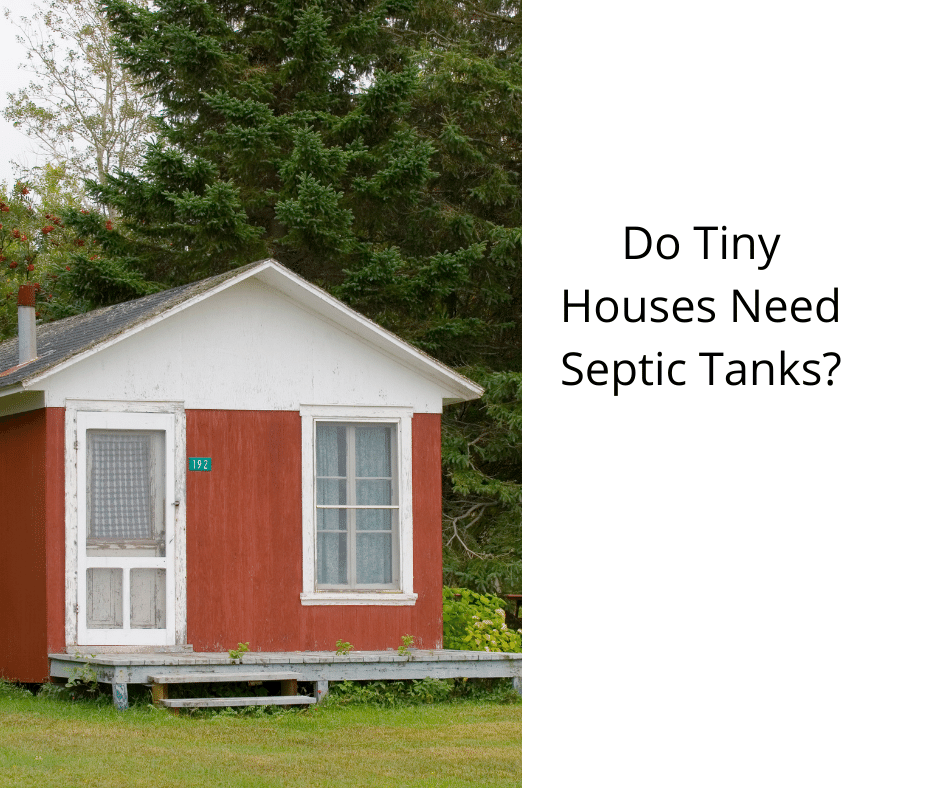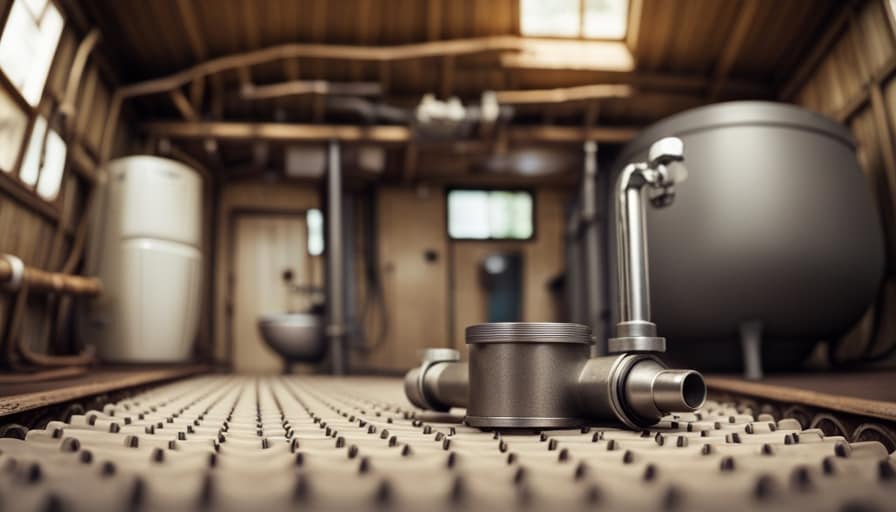A common question many ask is, “Do tiny houses need septic tanks?” The answer is yes. There are several reasons for this. Firstly, septic tanks require a lot of space, which can be challenging in crowded areas. Secondly, they require on-site leach fields. Thirdly, the cost of septic tanks can be expensive. Fortunately, there are several alternative options available. Keep reading to learn more about these alternatives.
Alternatives to Installing a Septic Tank in A Tiny House
Installing a septic system is an important consideration if you’re planning to live in a tiny house. A septic tank is an underground chamber where waste material is gathered until it’s treated. They can be made of plastic, concrete, or glass. Finding a professional who can install them properly and keep the area odor-free is important.
There are many advantages to installing a septic system. First of all, it’s important to consider the location. Since a tiny home may be on wheels or a trailer, its level depends on the ground underneath. The septic tank must be located far enough away from the home to prevent settling of the ground and softening of the surrounding soil. It’s also important to consider the impact of heavy rains and groundwater on the system.
Another alternative is to install a portable holding tank. This device can catch used water from the tiny house and transport it to a suitable location to be dumped. You can then use it to wash your car and water your plants. This is a practical option for tiny houses off the grid. You can install a pump if you need to, but remember that a tank is a bigger investment than a portable water container.

Another advantage to installing a septic tank in your tiny house is that it’s much easier to install than a traditional one. There are different ways to install one, depending on your needs. One of the most common solutions is to install a septic system around your tiny house. The septic tank can be situated outside or under your house. The septic tank is connected to drainage pipes that lead outdoors. The liquid that flows from the tank’s interior is then released into the soil.
Another alternative to a concrete septic tank is a lightweight fiberglass or plastic tank. These tanks do not take up too much space and are cheaper. However, they do have a shorter lifespan than a concrete tank. However, steel tanks may be more expensive, and the labor involved can cost as much as $1600. In addition, they can also affect the groundwater, which can also damage the septic system.
A septic system can be costly to install and can be as much as $1,500 or more depending on the size of the building and the amount of groundwork needed to prepare the area. Then, there’s the cost of pumping the system every three to five years, which can add up. On the other hand, a holding tank system is much easier and more portable. The downside of a holding tank system is that the system must be installed in a location that allows for easy transport.
If you don’t have sewer access, you may be able to install a composting toilet. However, you must check with local authorities before installing a composting toilet. It’s not recommended for tiny houses, as it may cause issues. However, if you have a sewer in your area, you might be able to install a septic tank.
Disadvantages of Installing a Septic Tank in A Tiny House
Tiny houses often sacrifice a bathroom in the name of simplicity, but that doesn’t mean that they can’t have one. Portable septic tanks and composting toilets can only hold a limited amount of waste, and tiny houses may need to be built with permanent septic tanks. These tanks improve the quality of water and toilets, and there are four different ways to install them.
When choosing a septic system, you should consider the benefits and drawbacks of each type. One major benefit of a septic system is that it only needs pumping out once every three to five years, whereas a holding tank system will need pumping out every couple of weeks. However, a tiny house may not have a suitable ground space for a septic system. The best way to install a septic tank in a tiny house is to hire a septic specialist, who will ensure the system is installed properly and won’t take up too much space.
Installing a septic system is difficult for a tiny house, because the land is small. A tiny house’s limited space for installation means that the tank must be placed on an elevated area. However, fiberglass tanks are lightweight, making them easier to move and install. Another advantage is that fiberglass tanks are resistant to damage by roots and can last up to 40 years.
Another disadvantage of installing a septic tank is the distance between the tank and the house. This means that the septic tank needs to be located between 10 to 25 feet from the house. This distance means that the tank has to be far away from any water source, trees, and other structures. It can also mean that the septic tank needs to be installed uphill from the house.
Installing a septic system in a tiny house also entails a substantial investment. The installation of a septic system will cost you anywhere from $720 to $10,000. This is a large amount of money for a tiny house, but it will allow you to be independent. It will give you freedom and the opportunity to use your own plumbing without interfering with the community sewage system.
Another disadvantage to installing a septic tank in septic tanks is that tiny houses will need to be built on a foundation that allows for the installation of pipes. While there are some advantages to building a tiny house, it is not practical for some reasons. If your tiny house is meant to be portable, installing expensive pipes may not be viable. As a result, some tiny houses on wheels store their wastewater in separate tanks and dispose of it at a dump site. If your tiny house is stationary, it may be necessary to use composting toilets or incinerators to treat black water.
One disadvantage of a bucket system is that the odors will continue to escape the tiny house, so you may have to use a public bathroom. Of course, having your own bathroom is a luxury. But, for those who prefer to live off the grid, or are looking for a way to reduce their dependence on water, this is an excellent option. A composting toilet is a great option for tiny houses and off the grid.
Cost of Installing a Septic Tank in A Tiny House
Installing a septic system in a tiny house is not an easy process. First, you need to obtain a building permit, which can run you around $1,000. There are several different types of septic systems, including above-ground and below-ground systems. Above-ground systems require less maintenance and ventilation than below-ground ones. However, a basic below-ground anaerobic septic system costs approximately $6000 to $7000.
The location of your septic tank is very important, because it will affect the level of your tiny home. The ground under your tiny house may be soft or have holes in it. You must choose a location away from the house that will not be affected by groundwater or heavy rain. You can also hire a professional to install a septic tank so that you can run plumbing lines directly into it.
The cost of a septic system will vary depending on where you live and how much your home is worth. It will be higher if you live in a town with a high cost of living. So, compare septic costs in different towns to determine what you can expect. Once you’ve compared the prices, you’ll have a good idea of what the septic tank installation process will cost.
When you’re ready to move forward with the installation, the process should be simple. The system has several components, including a septic tank and drainage pipes that lead outside and underneath the house. A septic tank separates solid waste from floatable materials and releases them into a drainfield. The drainfield is typically a sand or constructed wetlands. A septic tank can cost between $5,000 and $6,000, so it’s important to consider all of your options before starting the installation process.
When you’re ready to install a septic system, you’ll need to know the rules and regulations in your area. In some areas, installing a septic system without a permit is illegal. It’s best to contact your local code officials to get more information about the process. It’s better to go through a licensed installer than try to install a septic system on your own.
Plumbing is a vital part of a house, but in a tiny house, you can be creative with the design and placement of certain systems. It is also important to note that the price of plumbing is lower than that of a regular residence. It’s estimated that a one to three-person tiny house will cost around $700 to $900 to install a complete plumbing system. The price does not include the cost of labor. Typically, plumbers charge $75 to $130 per hour.
There are two types of septic tanks. One is made of steel, while the other is made of fiberglass. If your tiny house is older than two decades, you might want to choose another type of tank, such as concrete. Plastic and fiberglass tanks are less expensive than steel. Steel tanks are prone to rusting, and if you live in an older house, you’ll need to make sure the tank is properly installed. In addition, steel tanks can corrode and need to be replaced after 20 to 25 years.
Hi, I’m Emma. I’m the Editor in Chief of Tiny House 43, a blog all about tiny houses. While tree houses are often associated with childhood, they can be the perfect adult retreat. They offer a cozy space to relax and unwind, surrounded by nature. And since they’re typically built on stilts or raised platforms, they offer stunning views that traditional homes simply can’t match. If you’re looking for a unique and romantic getaway, a tree house tiny house might just be the perfect option.










